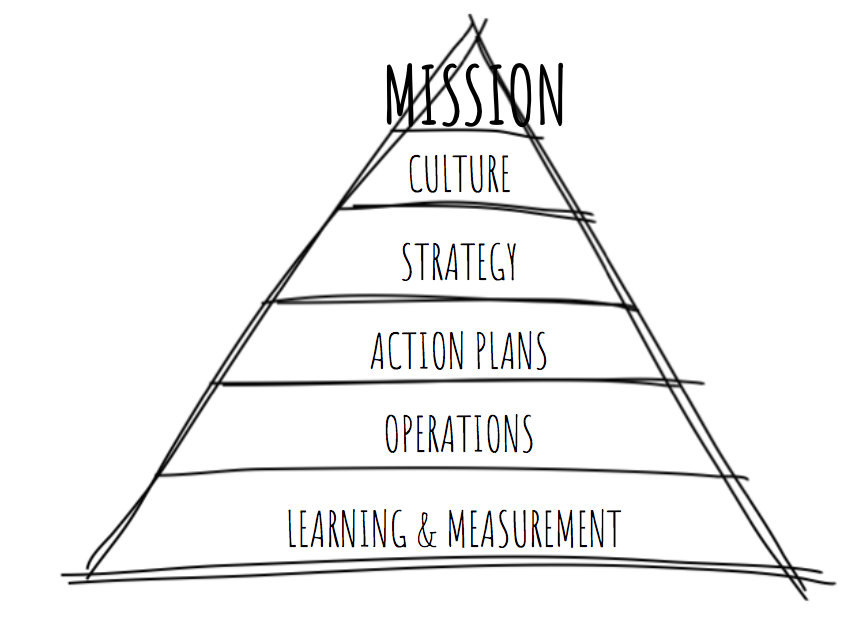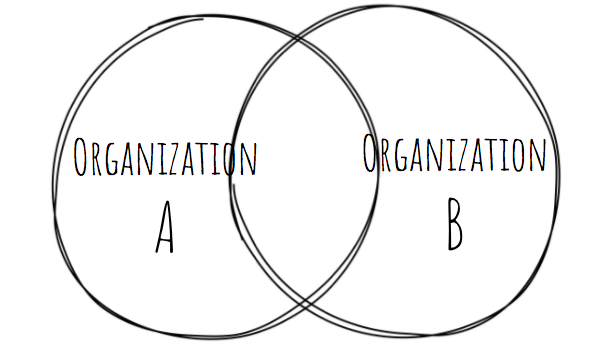Alliances & Mergers: Mission Matchmaking
Mission! It is a powerful word. In the charity sector, it is the reason some of us get up in the morning. It conveys a sense of urgency and purpose. And fundamentally “mission” explains an organization’s reason for existence.
Charitable organizations are by definition mission driven. Few people join a charity for the pay, and those that do generally move on quickly. Similarly, board director posts are often unpaid and come with little influence or personal gain. This is as it should be – the currency of a charity is the compelling nature of its mission.
The nonprofit mission hierarchy
What then is the role of aligning missions for strategic alliances or mergers? Should the missions be identical? Similar? Completely different? The question matters when you consider the nonprofit hierarchy in figure 1.0. If you get mission wrong, the ship is sunk.
There can be many motives for strategic alliances and mergers. Unlike the for-profit sector, the reasons are not limited to competition and self interest. To be sure, sometimes the effort is financially driven to keep a charity above water, purchase donors lists, or gain scale. But hopefully the majority of alliances and mergers are the result of strategic leaders recognizing that 1+1 can actually equal 3 when the synergies of a sound alliance or merger create impact beyond simple arithmetic.
So what role does the mission play in collaboration? Counterintuitively, having nearly identical missions is not the answer to a smooth consolidation. When two all-but-identical charities get together, the best-case scenario is achieving economies of scale and efficiencies from back-office consolidation. It may be helpful, but it’s not exponential. In short, you are deciding who is the better help-desk employee and writing severance packages for the rest. But it is also true that charities with little in common do not make good stablemates either. The reasons here are more obvious, because without some common ground the two organizations have little to build on. In such cases, donors, the public, and even employees are confused.
What is needed for 1+1 to equal 3 is the organizational equivalent of chocolate and peanut butter joining together to make… heaven. The sum of the two is far better than each on its own and the combined result creates something that opens up entirely new possibilities.
Mission Overlap
This chart roughly demonstrates the degree of overlap a charity should consider when seeking a strategic partnership, alliance or merger, but particularly at the mission level.
The value of semi-overlapping missions are many. For each organization, there are bedrock values and goals that are true across both organizations. Often, the social good the organizations seek to create are the same, but the approaches are different. At a program level, this creates new opportunities for interventions to be combined in ways that achieve greater outcomes, possibly reaching new beneficiaries. Donors can see a connection between their previous giving and new opportunities to give to a more efficient, high-impact organization. In short, this type of missional overlap doesn’t just double the effectiveness of each organization, it exponentially increases it.
With over 1.5 million charities in the country (that’s 36 for every zip code), the nonprofit sector is the poster-child for industries in need of consolidation. The process of finding a partner charity that is the right combination of similar, but different, starts with an analysis of mission. When done right, the result can be impact beyond what either charity could envision on its own. A whole new thing…


